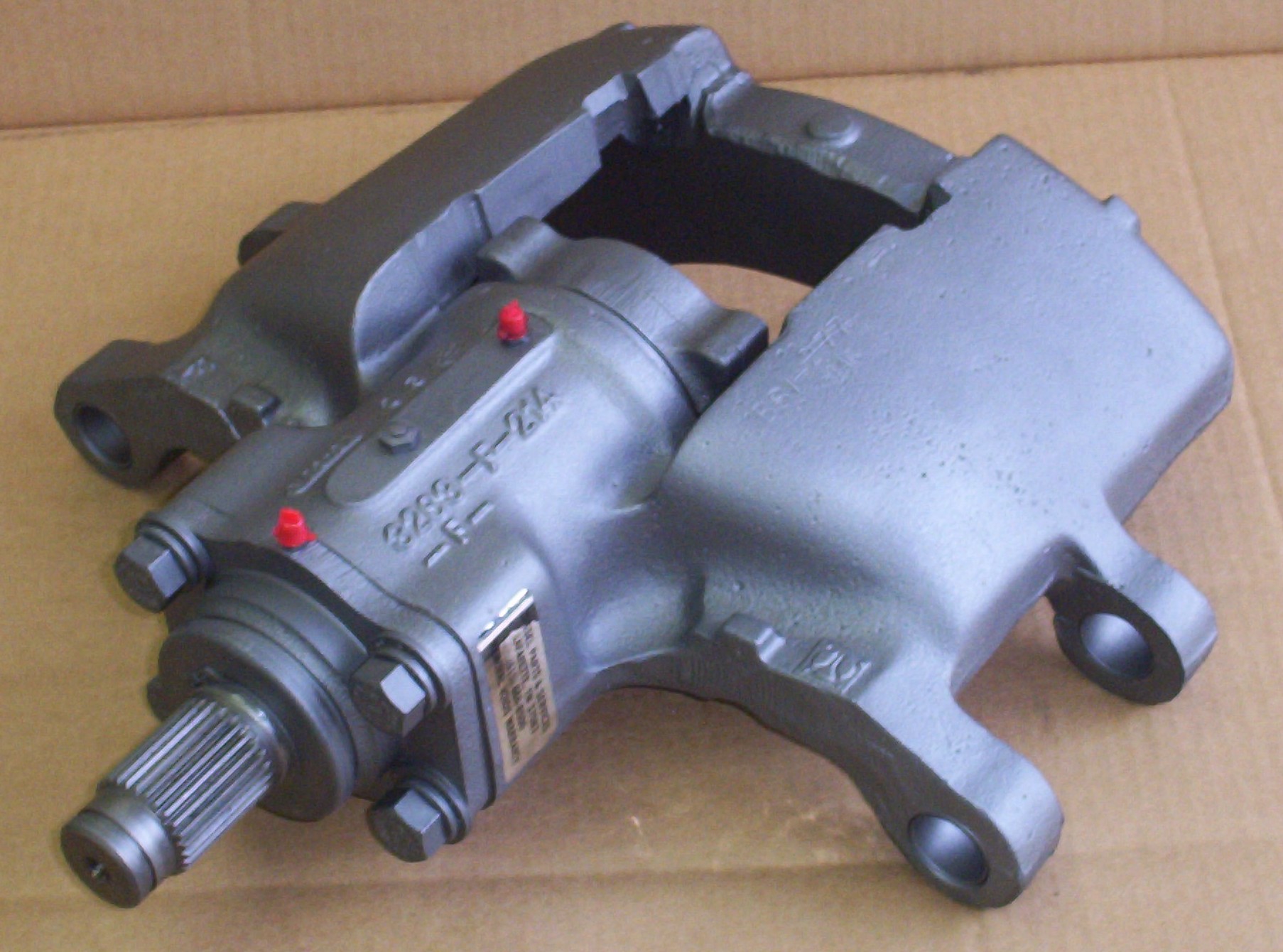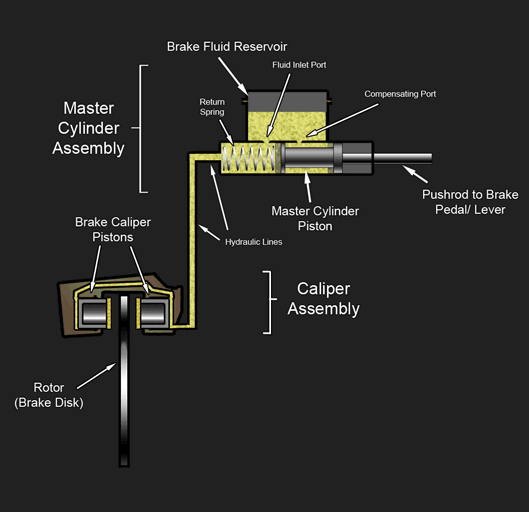For those wanting a more long winded explanation of how these things actually work (check Tune-A-Fish's lovely piston pic):
" Keep in mind that the one way valving action of the master is extremely effective, and that it works just as well with air as it does with fluid, so any air in front of the piston will never come back to the reservoir unless the master is bad. The air bubbles you may see bubbling up in the reservoir are from the space between the two seals on the piston, the back seal that keeps the master from leaking, and the front seal which works as the one way valve. That portion of the system between the seals is self bleeding. Everything else has to bleed elsewhere. The problem often is that there is such a large volume of air directly in front of the piston, that it just moves back and forth with the piston, and there is not enough negative pressure to keep drawing fluid past the one way valving action because the system is mostly filled with air. Any tiny bit of fluid that is drawn in trickles down to the caliper, where it gets removed by attempted bleeding and the interior air volume stays the same. You keep removing fluid but never any air. Even if air is removed on one stroke of the master, it can be possible that when the lever is released increasing the system volume, the tiny negative pressure left after the air expands is simply not enough to draw in much fluid. This makes bleeding impossible, or at the least seem that way. Nothing in front of the front seal can back-track unless the master is bad, so if air is there, gravity will keep it there because that banjo fitting is usually the highest point in the system. The reservoir may be higher but that is irrelevant as there is not enough head pressure to push fluid past the seal to the front of the piston. Bleed the air out at the banjo, and fluid can trickle down the line to mostly fill it because the air can escape (also keep in mind that most lines are small enough that fluid resists allowing air to percolate upward through it against gravity due to surface tension. Fluid does indeed "trickle down", but with considerable resistance.). More importantly, the large volume in front of the piston can also fill for the same reason. This makes the system volume mostly filled with fluid, but more importantly, not with much air. The air is very compressible, and if too much is in the system, it is enough to be able to expand quite a lot before fluid is forced passed the one way valving action at the master and nothing happens. Replace that volume with in-compressible (also un-expandable (sort of)) fluid and the pumping action can take place and you can bleed the remaining air at the caliper. Once there is enough fluid and little enough air in the system, the master can push fluid very aggressively through it. Enough so that air bubbles in the small diameter lines are driven along with fluid down the lines (before they can bubble up back to the banjo) into the calipers where they can be purged with the bleeders."
It may also be of value to see how the system functions under normal operating conditions.
Once the system is purged of air, and the brake pads are against the rotor, the fluid reservoir becomes an irrelevant system component, as well as the fluid trapped beneath it between the two seals on the mc piston. When you squeeze and release the lever, the fluid below the reservoir, and the fluid in front of the piston just go back and forth. When you squeeze the lever, the piston pushed fluid down the line adding temporary volume at the caliper and squeezes the rotor. The actual displacement of the caliper piston(s) is very small, and most of the time is not enough to actually slide the piston against its seals. The seal merely distorts with its point of contact on the piston not changing. It is this elasticity of the seal which draws the piston back into its bore slightly when the hydraulic pressure is released when you release the lever. The seal acts as a spring to retract the brake. So most of the time, the fluid between the mc piston and the caliper piston never changes - it just goes back and forth between the two. As the linings wear, the caliper piston(s) gradually have to travel further, and further until the seal can not deflect enough and the piston(s) slides a bit against the seal. When this happens, the seals can only return to their previous normally retracted position lifting the pads off of the rotor, but as the piston(s) have moved ahead slightly creating a larger volume inside the caliper, negative pressure will be created when the lever is released. When this happens, fluid will be drawn past the front mc piston seal to replenish the needed volume. So unless the system leaks, the only fluid you ever use out of the reservoir is still in the system and is a direct indication of how far the brake linings have worn.
" Keep in mind that the one way valving action of the master is extremely effective, and that it works just as well with air as it does with fluid, so any air in front of the piston will never come back to the reservoir unless the master is bad. The air bubbles you may see bubbling up in the reservoir are from the space between the two seals on the piston, the back seal that keeps the master from leaking, and the front seal which works as the one way valve. That portion of the system between the seals is self bleeding. Everything else has to bleed elsewhere. The problem often is that there is such a large volume of air directly in front of the piston, that it just moves back and forth with the piston, and there is not enough negative pressure to keep drawing fluid past the one way valving action because the system is mostly filled with air. Any tiny bit of fluid that is drawn in trickles down to the caliper, where it gets removed by attempted bleeding and the interior air volume stays the same. You keep removing fluid but never any air. Even if air is removed on one stroke of the master, it can be possible that when the lever is released increasing the system volume, the tiny negative pressure left after the air expands is simply not enough to draw in much fluid. This makes bleeding impossible, or at the least seem that way. Nothing in front of the front seal can back-track unless the master is bad, so if air is there, gravity will keep it there because that banjo fitting is usually the highest point in the system. The reservoir may be higher but that is irrelevant as there is not enough head pressure to push fluid past the seal to the front of the piston. Bleed the air out at the banjo, and fluid can trickle down the line to mostly fill it because the air can escape (also keep in mind that most lines are small enough that fluid resists allowing air to percolate upward through it against gravity due to surface tension. Fluid does indeed "trickle down", but with considerable resistance.). More importantly, the large volume in front of the piston can also fill for the same reason. This makes the system volume mostly filled with fluid, but more importantly, not with much air. The air is very compressible, and if too much is in the system, it is enough to be able to expand quite a lot before fluid is forced passed the one way valving action at the master and nothing happens. Replace that volume with in-compressible (also un-expandable (sort of)) fluid and the pumping action can take place and you can bleed the remaining air at the caliper. Once there is enough fluid and little enough air in the system, the master can push fluid very aggressively through it. Enough so that air bubbles in the small diameter lines are driven along with fluid down the lines (before they can bubble up back to the banjo) into the calipers where they can be purged with the bleeders."
It may also be of value to see how the system functions under normal operating conditions.
Once the system is purged of air, and the brake pads are against the rotor, the fluid reservoir becomes an irrelevant system component, as well as the fluid trapped beneath it between the two seals on the mc piston. When you squeeze and release the lever, the fluid below the reservoir, and the fluid in front of the piston just go back and forth. When you squeeze the lever, the piston pushed fluid down the line adding temporary volume at the caliper and squeezes the rotor. The actual displacement of the caliper piston(s) is very small, and most of the time is not enough to actually slide the piston against its seals. The seal merely distorts with its point of contact on the piston not changing. It is this elasticity of the seal which draws the piston back into its bore slightly when the hydraulic pressure is released when you release the lever. The seal acts as a spring to retract the brake. So most of the time, the fluid between the mc piston and the caliper piston never changes - it just goes back and forth between the two. As the linings wear, the caliper piston(s) gradually have to travel further, and further until the seal can not deflect enough and the piston(s) slides a bit against the seal. When this happens, the seals can only return to their previous normally retracted position lifting the pads off of the rotor, but as the piston(s) have moved ahead slightly creating a larger volume inside the caliper, negative pressure will be created when the lever is released. When this happens, fluid will be drawn past the front mc piston seal to replenish the needed volume. So unless the system leaks, the only fluid you ever use out of the reservoir is still in the system and is a direct indication of how far the brake linings have worn.






